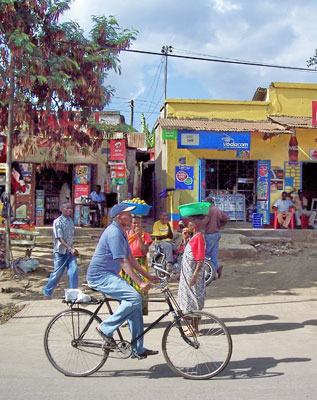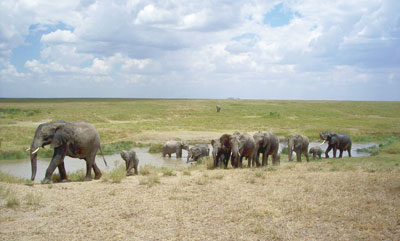Kenya and Tanzania: Serengeti to Arusha
This item appears on page 62 of the July 2011 issue.
by Randy Keck (Third of three parts, go to part one or part two)
The final portion of my February-March 2011 exploration of Kenya and Tanzania began with a drive from Ngorongoro Crater to Olduvai Gorge, where Mary and Louis Leakey painstakingly excavated the remains of some of the first humans to ever walk the Earth in an upright position. Many of their fascinating finds are on display at a small museum overlooking the gorge.
We continued on to the Serengeti, Tanzania’s eldest and most popular national park. This UNESCO World Heritage Site is best known, along with the neighboring Masai Mara in Kenya, for the massive annual migration of wildebeest — accompanied by gazelle and zebra — which move in an annual cycle in search of better grazing and water. Optimum migration-viewing periods can change each year, depending on conditions.
For anyone heading to the Serengeti, I recommend a stop at the visitor center, near the main airport, on the day you arrive at the park, as it features a self-guided walking trail with highly informative exhibits on the local geology, water holes, interrelationships of the wildlife, etc.
Serengeti kopjes abound
A distinguishing natural feature of the Serengeti is the multitude of kopjes that dot the landscape. These are actually the rock heads of mountains protruding above the surface of the Serengeti plains, with each serving as a mini-botanical garden/oasis due to the effects of the moisture stored by the rocks. The larger kopjes, in particular, are havens for a variety of wildlife, including leopards.
Our initial game drive into the park began with a flurry as my guide and I encountered two lions at a water hole devouring the leg of a warthog taken earlier. It was destined to be a day of idyllic, nonstop wildlife-viewing action, including our sighting the “Big Five.”
Highlights of the day included observing a herd of elephants, with several babies frolicking in the river for an extended period, and the surreal sight of a leopard that had somehow maneuvered and stashed his impala kill over 20 feet above the ground in a sausage tree for later consumption.
My base in this wildlife mecca was the serene Serengeti Serena Safari Lodge, set on a hill with a 360-degree view of the surrounding savannah. The grounds were unfenced, so evening walks to outlying rooms required flashlights and some caution.
While I was enjoying a massage on my final evening, the lodge security staff suddenly sprang into action, as a leopard had been spotted less than 100 feet from the massage tent. Perhaps it was the aroma of the massage oil that had attracted the wandering hunter.
My final two game drives in the Serengeti and East Africa were to be as productive as the first, featuring great variety, including excellent cheetah sightings and an afternoon finale at a pool brimming wall to wall with hippos and crocodiles.
As we ventured back to the lodge, a colorful rainbow appeared on the horizon. The rainy season in East Africa had begun.
Arusha postscript
The last day of my East Africa journey was spent in Arusha based at the historic Arusha Hotel, where many scenes from John Wayne’s “Hatari” were filmed in the early 1960s. Over the years, the recently renovated property has hosted a number of famous guests.
Dining on the outdoor patio at the Arusha, I discovered the delights of sesame-crusted deep-fried avocado ($5) and bouillabaisse perfection ($12).
The Arusha Hotel is centrally located, and guests can easily walk to the local Masaai outdoor market and two museums. Also down the street, the UN tribunal on Rwanda war crimes was in session.
The twin peaks of nearby Mt. Meru tower over the city, but Meru was content to remain uncooperatively wrapped in cloud cover during my brief stay.
On the outskirts of Arusha, I visited the beautiful Serena Mountain Village lodge in a botanical garden setting replete with walking trails and a crocodile-free canoeing lake. I can certainly recommend this most impressive historic lodge as a post-safari stopover option.
My final drive from Arusha to the Kilimanjaro Airport unveiled a kaleidoscope of main road and local village sights as the locals went about their daily lives. They would not miss this singular departing soul, but he would definitely miss them.
Game-viewing tip
Optimum game viewing in the hills and savannahs of East Africa requires quality binoculars. There are constant opportunities for lengthy viewing sessions, which with compact models require steadiness.
Typically, with all but the highest-quality and highest-cost ten-power compact models, one will experience some vibration and accompanying eye discomfort. With good-quality or better eight-power magnification, this problem can usually be avoided.
Much less common nine-power models can provide a happy medium, as I discovered with my new, waterproof and fogproof Nikon 9x25 ProStaff binoculars, which were easy on the eyes and performed seamlessly on safari.
Before you go
My journey to Kenya and Tanzania was partially sponsored by ITN advertiser SITA World Tours (Encino, CA; 800/421-5643). My itinerary was similar to their “Kenya and Tanzania Highlights” tour but with a few modifications. SITA offers a wide range of Africa touring options as well as an extensive array of tours worldwide.
Keck's Beyond the Garden Wall
❝ To understand the addictive allure, combine vibrant equatorial African cultures and landscapes with pulsating game viewing at sublimely cooling elevations and one has exoticism without equal ❞
— Randy acknowledging why many feel compelled to return to Kenya and Tanzania for repeat safari experiences


